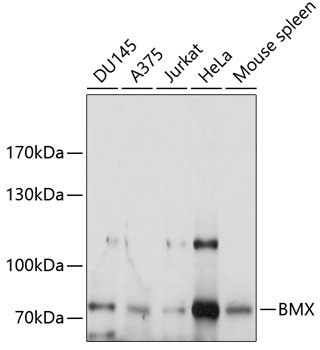-
Product Name
BMX Polyclonal Antibody
- Documents
-
Description
Polyclonal antibody to BMX
-
Tested applications
WB
-
Species reactivity
Human, Mouse
-
Alternative names
BMX antibody; ETK antibody; PSCTK2 antibody; PSCTK3 antibody; BMX non-receptor tyrosine kinase antibody
-
Isotype
Rabbit IgG
-
Preparation
Antigen: Recombinant fusion protein containing a sequence corresponding to amino acids 1-120 of human BMX (NP_001712.1).
-
Clonality
Polyclonal
-
Formulation
PBS with 0.02% sodium azide, 50% glycerol, pH7.3.
-
Storage instructions
Store at -20℃. Avoid freeze / thaw cycles.
-
Applications
WB 1:500 - 1:2000
-
Validations

Western blot - BMX Polyclonal Antibody
Western blot analysis of extracts of various cell lines, using BMX antibody at 1:1000 dilution.Secondary antibody: HRP Goat Anti-Rabbit IgG (H+L) at 1:10000 dilution.Lysates/proteins: 25ug per lane.Blocking buffer: 3% nonfat dry milk in TBST.Detection: ECL Enhanced Kit .Exposure time: 5s.
-
Background
Non-receptor tyrosine kinase that plays central but diverse modulatory roles in various signaling processes involved in the regulation of actin reorganization, cell migration, cell proliferation and survival, cell adhesion, and apoptosis. Participates in signal transduction stimulated by growth factor receptors, cytokine receptors, G-protein coupled receptors, antigen receptors and integrins. Induces tyrosine phosphorylation of BCAR1 in response to integrin regulation. Activation of BMX by integrins is mediated by PTK2/FAK1, a key mediator of integrin signaling events leading to the regulation of actin cytoskeleton and cell motility. Plays a critical role in TNF-induced angiogenesis, and implicated in the signaling of TEK and FLT1 receptors, 2 important receptor families essential for angiogenesis. Required for the phosphorylation and activation of STAT3, a transcription factor involved in cell differentiation. Also involved in interleukin-6 (IL6) induced differentiation. Plays also a role in programming adaptive cytoprotection against extracellular stress in different cell systems, salivary epithelial cells, brain endothelial cells, and dermal fibroblasts. May be involved in regulation of endocytosis through its interaction with an endosomal protein RUFY1. May also play a role in the growth and differentiation of hematopoietic cells; as well as in signal transduction in endocardial and arterial endothelial cells.
Related Products / Services
Please note: All products are "FOR RESEARCH USE ONLY AND ARE NOT INTENDED FOR DIAGNOSTIC OR THERAPEUTIC USE"
